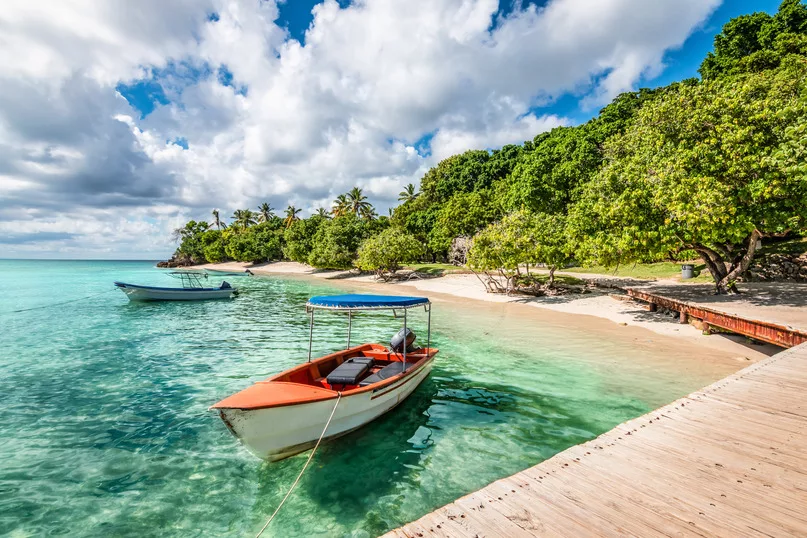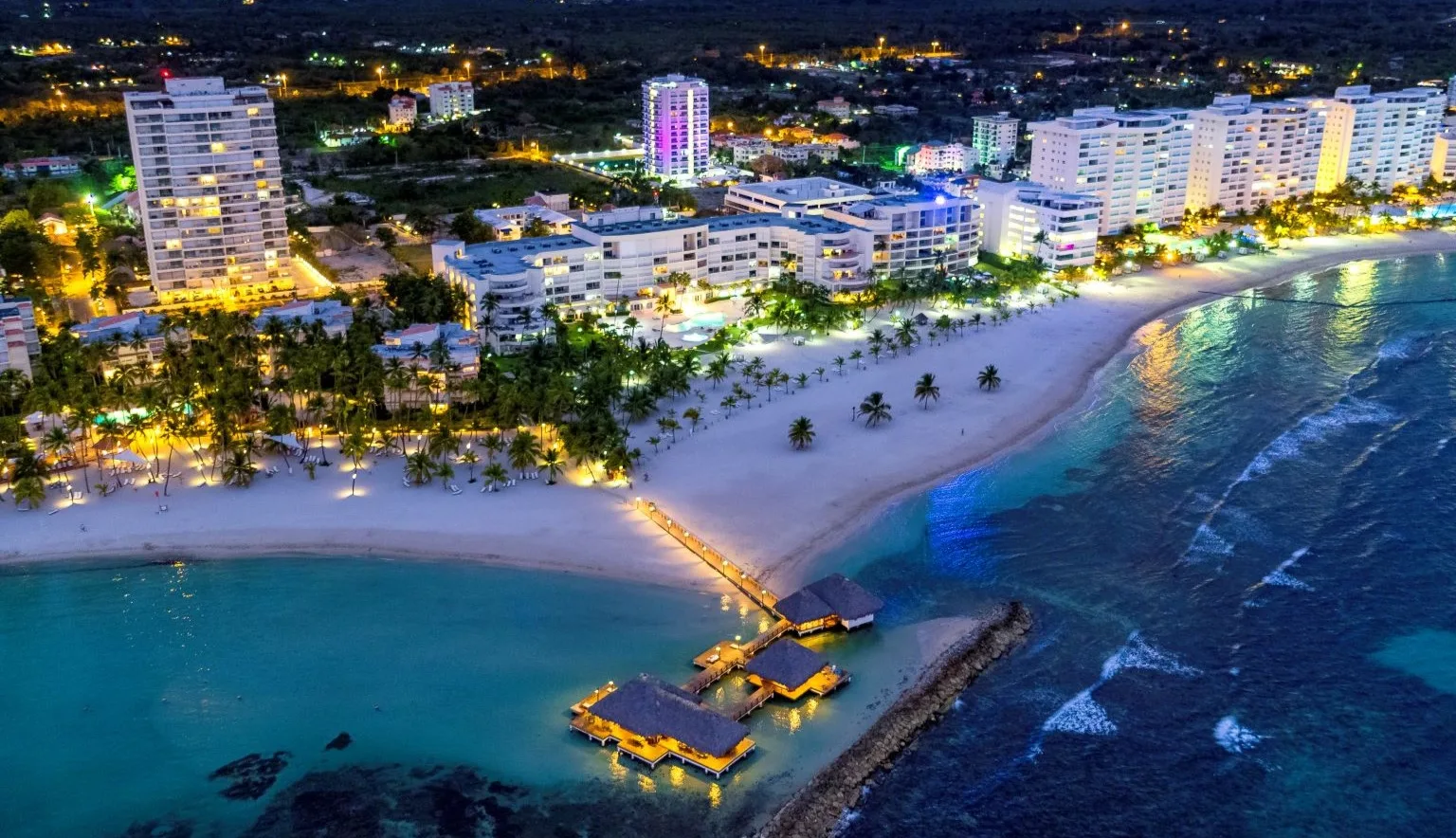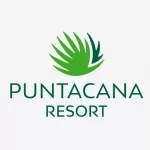The Dominican Republic is a captivating Caribbean destination with a diverse topography and a brimming cultural calendar that leaves visitors with unforgettable memories of this natural utopia.
THE DOMINICAN REPUBLIC
The appeal of the Dominican Republic is its ability to cater to a wide range of travellers; whether you are seeking adventure, relaxation, or cultural experiences, the island can deliver in copious amounts. The coastline of silky white sand, which gleams like crushed diamonds against the turquoise waters of the sun-dappled Caribbean Sea and Atlantic Ocean, is interspersed with rocky escarpments. However, this paradisiacal landscape is more than 1,000 miles of stunning beaches – lush rainforests, arid deserts, and majestic mountains also characterise its outstanding beauty.
As the oldest country in the Americas and the second-largest island in the Caribbean after Cuba, the region was initially known as Hispaniola before being divided into Haiti and the Dominican Republic in 1607. Dominican multiculturism blends Indigenous Taino, African, and European influences, resulting in a vibrant and unique identity. The country is known for its music, dance (including merengue and bachata), art, and cuisine. The latter is a delightful blend of flavours, featuring dishes such as mofongo (mashed plantain), sancocho (a hearty soup), tostones (fried green plantains), and fresh seafood, alongside its tropical fruits like mangoes, guavas, and papayas.
One of the Caribbean’s most modern and dynamic metropolises is the Dominican Republic’s capital, Santo Domingo. It serves as an economic, political, and cultural centre and is home to many significant landmarks from the time of Christopher Columbus. The Dominican Republic offers a rich tapestry of experiences, from exploring historical sites in Santo Domingo to lounging on world-class beaches or venturing into the country’s diverse landscapes. It’s a destination that can satisfy a wide range of interests, making it a popular choice for travellers seeking relaxation and adventure in the Caribbean.
If you are interested in visiting the local neighbourhoods, it is recommended that you book a specific tour guide for these areas. For example, if you want to learn more about the history of African slaves in the Dominican Republic, uniquely, Santo Domingo offers a tour accompanied by a deeply knowledgeable guide. Additionally, if you would like to experience the local nightlife and see how and where the Dominicans celebrate their evenings and nights, you can head out on a personalised nightlife tour to connect and dance with the locals. Dominicans are known for their warmth and friendliness, so visitors often encounter hospitality and a genuine interest in sharing their culture with tourists.
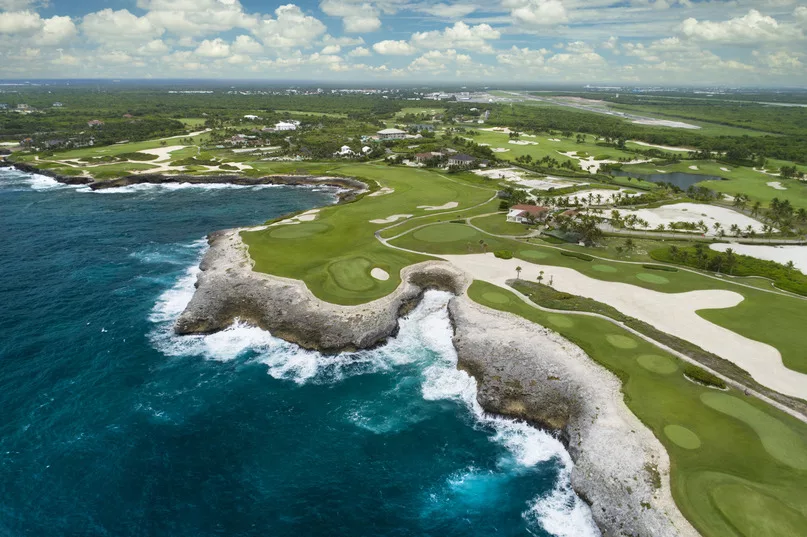
TOURISM INSIGHTS: ASONAHORES
As a prominent industry association in the Dominican Republic, ASONAHORES plays a vital role in promoting and supporting the development of its growing tourism industry, advocating for the interests of the country’s hospitality and travel sector.
ASONAHORES’ activities include providing resources and training for hospitality professionals, organising events and initiatives to boost tourism and related businesses, and shaping and advancing the tourism sector of the Dominican Republic’s economy. David Llibre, President, tells us more.
Q&A WITH DAVID LLIBRE, PRESIDENT, ASONAHORES
Can you talk us through the origins of ASONAHORES and its initial vision?
David Llibre, President (DL): The Hotel and Tourism Association of the Dominican Republic (ASONAHORES), is one of the oldest business associations in the country. It was established over 60 years ago as the National Hotel and Restaurants Association to represent the industry, promote tourism development, and establish actions between the government and the private sector.
The association emerged in 1962, due to the new socio-economic freedoms, representing a third of the 800 total hotel rooms in the country at that time and the most renowned restaurants in Santo Domingo.
By the end of the 1980s, the organisation went through an adaptation process to support the development of the tourism industry beginning to emerge in the East and already taking place in the North region, specifically in Puerto Plata.
With the emergence of the first regional hotel associations, ASONAHORES became a federation and created a new work plan in which it oversaw national scope matters, whilst the regional associations took care of issues specific to their respective areas with the support of the national organisation.
In 2010, ASONAHORES changed its bylaws to transform into an association that brings together the whole tourism sector, including hotels, airports, ports, real estate companies, tour companies, regional hotel associations, restaurant associations, and other organisations operating within the industry. As a result, ASONAHORES changed its name to the Hotel and Tourism Association of the Dominican Republic.
ASONAHORES membership includes the leading allied companies that supply services or products, thus assuming the role of a representative entity for all the tourism sector’s interests as a national productive activity.
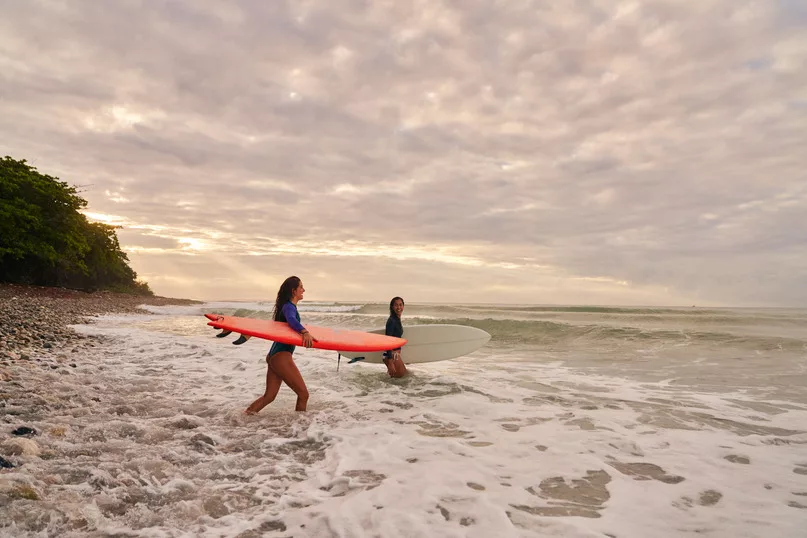
Why should someone visit the Dominican Republic, and what type of travellers do the islands appeal to the most?
DL: The Dominican Republic has much to offer for every type of tourist. We are primarily known for our beaches and the range of hotel accommodations, featuring the presence of major hotel chains. This, together with the number of attractions our country offers, makes us a point of reference throughout the Caribbean region.
In addition, we have a variety of sports, recreation, and entertainment options, with luxurious and diverse accommodations. Still, the country offers rich cultural attractions and historical monuments, such as the Colonial City, the oldest city in America, where houses from that period are still preserved. We also maintain our ancestral flavour in gastronomy, whilst expanding our tourist offerings in ecotourism and adventure activities, national parks, mountain ranges, and rivers.
Similarly, in recent years, we have seen how health, shopping, events, and business tourism have consolidated in our country, further diversifying what our beautiful country has to offer.
What were the contributing factors to the recovery of the tourism industry in the Dominican Republic?
DL: Due to the COVID-19 pandemic, almost all of our hotels closed their doors for the first time. All our collaborators, including agricultural and industrial suppliers, tour providers, restaurants, carriers and taxi drivers, and artisans, were severely affected by the lack of income due to the absence of international tourists.
ASONAHORES reacted immediately, and in coordination with the government and private entities representatives, a plan was designed to handle the situation. Measures were proposed in the financial, labour, and health fields, which helped guide the action to prevent the collapse of our sector. Another fundamental aspect was the establishment of special sanitary policies to begin the reactivation of the tourism sector, arranged by the tourism cabinet and executed jointly between the public and private sectors, implementing measures that had not been applied by any other country in the region, within these policies, we highlight:
- Establishment of health protocols against COVID-19 for the entire tourism sector
- Insurance policy to cover risks associated with COVID-19 for tourists, free of cost
- Hotels and restaurant employees were among the first groups to be vaccinated
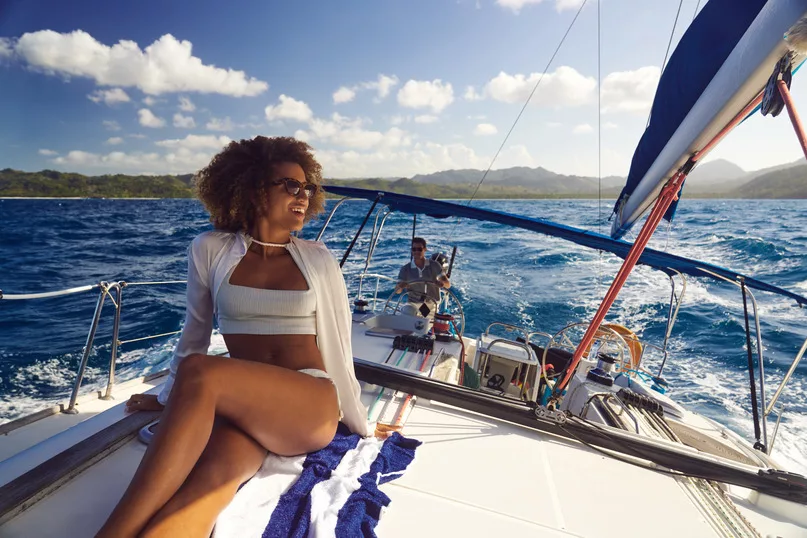
How do you market the Dominican Republic as both a luxury and cultural destination?
DL: The key is to promote the Dominican Republic as a complete destination, capable of responding to every tourist need, including the luxury and cultural markets.
Our Ministry of Tourism has a complete agenda with the objective of consolidating the position of the Dominican Republic in the main international markets and making new alliances that translate into the arrival of more tourists.
We are proud to be part of a special Marketing Committee where the public and private sectors meet regularly to create marketing strategies with the leading travel promoters, airlines, and other vital players in the tourism sector.
What ecotourism adventures does the Dominican Republic have to offer, and how is sustainability shaping the industry?
DL: The Dominican Republic is a vibrant country with much to offer regarding ecotourism adventures, including national parks, cenotes, ecological reserves, humid forests, desert areas, cliffs, caves, and waterfalls, among others.
Evidently, there are many options to indulge in adventures and pursue natural enjoyment, whilst still respecting the environment and local communities. I would recommend Constanza and Jarabacoa, in particular, as the main ecotourism adventure destinations.
On the other hand, in terms of sustainability, we have witnessed how hotels incorporate initiatives to measure and reduce energy use, water consumption, waste reduction, and carbon emissions. At the same time, they have established bedding reuse programmes, incorporated ecological cleaning products, and reduced single-use plastics. Hotels have also connected and contributed to their local communities.
I understand that this year is the 61st anniversary of ASONAHORES; how did you mark the occasion, and how has the Dominican Republic changed in the last 61 years regarding tourism?
DL: 61 years of growth trajectory has taught us that the life of business associations is a constant challenge and the story of ASONAHORES has been one full of learning.
With a formidable structure and international recognition, ASONAHORES is ready to continue consolidating itself and providing answers to the significant challenges we face in the country’s tourism sector. We acknowledge the legacy of nearly four generations of tourism leaders who made ASONAHORES the institution it is today and are committed to sustainable tourism development, allowing more tourists to experience the magic of one of the world’s most beautiful tourist destinations.
What are the association’s key priorities and goals for the future?
DL: We are committed to our three pillars: Sustainability, regulation, and air connectivity.
Regarding sustainability, we are committed to environmental practices in our industry, whilst also taking into consideration the socio-economic, cultural, and environmental aspects, allowing us to accurately manage the sustainability of tourism in the long-term.
In terms of regulations, we are working on proposals to regulate the vacation real estate accommodation currently offered through digital platforms. This will allow it to develop in an orderly and regulated manner without affecting the sustainability of the sector and the quality of our service offerings. Additionally, we wish to create a master plan for our tourist destinations, which considers the territory’s different aspects and ensures adequate development planning.
Finally, regarding air connectivity, we will continue encouraging new seats and routes and facilitating visitor migration processes, enabling our country to connect with more destinations. This will generate greater competition, and consequently, better airfares for our visitors.
What new things can the Dominican Republic offer to its tourists?
DL: The Dominican tourism industry aims to achieve the goal of receiving 10 million tourists in 2023. For the past two years, we have received over USD$1 billion in investment. These investments are directed towards established tourism destinations in our country, new areas like Miches and Pedernales, and the revitalisation of Puerto Plata through the Punta Bergantín project. At the same time, investment has been funnelled to develop complementary offers for our sector.
Meanwhile, we have also made extraordinary efforts to invest in new markets like South America, especially Brazil.
ASONAHORES has taken on the task of promoting each tourism destination in the country, promoting the Dominican Republic as a whole, and continuing to serve as a representative entity for our tourism sector.
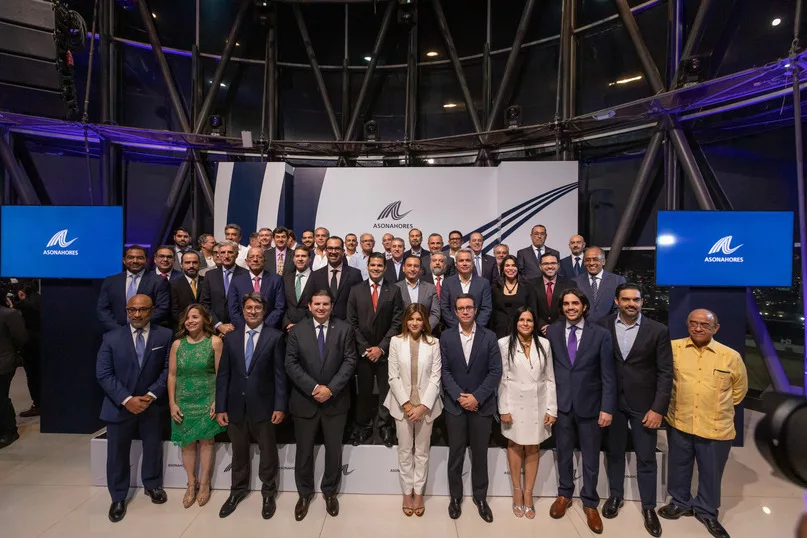
THE DOMINICAN REPUBLIC CULTURAL CALENDAR IN FOCUS
Filled with vibrant celebrations and festivals throughout the year, the Dominican diary is overflowing with the country’s most significant events and holidays. In an explosion of colour, music, and tradition, carnival celebrations and festivals are a cornerstone of Dominican culture; you will have difficulty finding a month in the year when there is not something to celebrate
iestas patronales, or patron saint festivals, are held at various times of the year in multiple towns as a wonderful expression of the modern side of the Dominican Republic’s Latino culture – from food to live music, drumming, and all-night partying; the parties last a little over a week.
Embracing its Spanish heritage, Día de los Reyes (Three Kings’ Day) heralds the arrival of the Three Wise Men, where parades and special church services take place on 6th January. Carnival in February and March is a lively and colourful affair, with parades, music, dance, and elaborate costumes. The most famous Carnival celebrations in the country are in La Vega and Santo Domingo.
July sees celebrations of the country’s national dance and music genre at the Festival de Merengue, whilst the Dominican Republic Jazz Festival, usually held in November, is renowned for featuring international and local jazz musicians. Locally known as Navidad, Christmas is a festive time with traditional music, decorations, and gatherings with family and friends.
These cultural events provide an excellent opportunity to experience the vibrant culture, music, and traditions of the Dominican Republic.
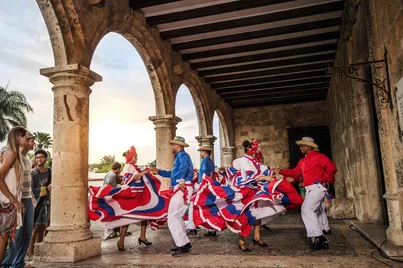
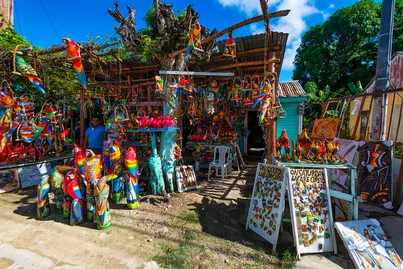
OUTLOOK RECOMMENDS
Do:
FOR AN EXCITING EXCURSION…
Cayo Levantado, also known as Bacardi Island, in Samaná Bay, is so-called due to a commercial the famous rum brand’s iconic commercial being filmed here. Boat taxis depart regularly from the Samaná port on the Avenida Marina. Spend the day swimming, sunbathing, kayaking, or paddle boarding, and enjoy the fresh fish.
FOR A CLIMB WITH A VISTA…
Pico Duarte is the highest peak in the Caribbean, and hiking to its summit is a challenging but rewarding adventure for outdoor aficionados. The hike offers spectacular views of the Dominican Republic’s mountainous interior.
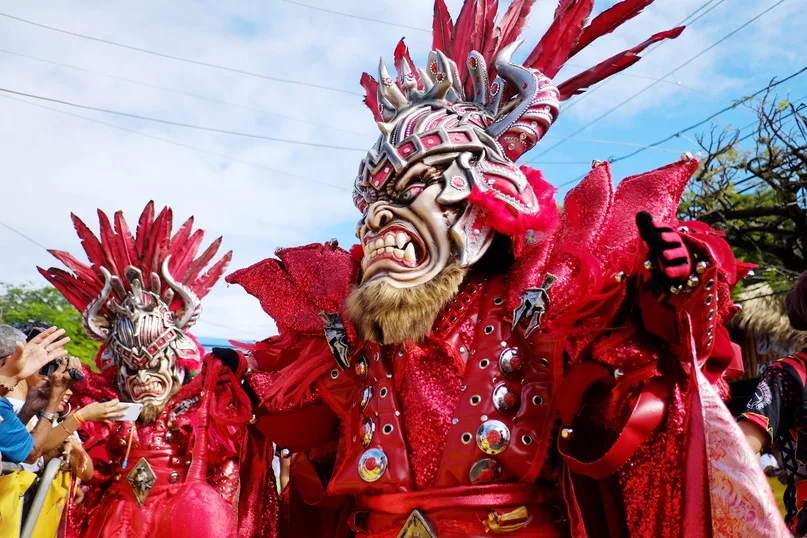
Eat:
FOR UNIQUE AND ELEGANT DINING…
AAA Three Diamond Award-winning La Yola Restaurant serves the freshest Mediterranean cuisine and seafood. Modelled on a fishing boat, the restaurant is perched on the sea at the Marina Puntacana Resort & Club, combining magnificent surroundings with sensational food.
The gated beachfront resort has a choice of accommodations in convenient locations, including the only AAA Five Diamond awarded hotel in the Dominican Republic, offering privacy, elegance, and personal service; it also features Oscar de la Renta’s first resort boutique. The Six Senses Spa will relax, revive, and rejuvenate, and there are plenty of activities with the golfing experience and three miles of white sandy shoreline.
FOR TRADITIONAL DISHES WITH A TWIST…
Buche Perico pays tribute to Dominican gastronomy in one of the city’s colonial-style buildings, once an old foundry. Spread under a magnificent glasshouse which lights up when night falls the restaurant’s menu whets your appetite with fish ceviche, octopus carpaccio, fresh tuna served with saffron risotto, and the signature Buche Perico – a Moca corn and sausage stew.
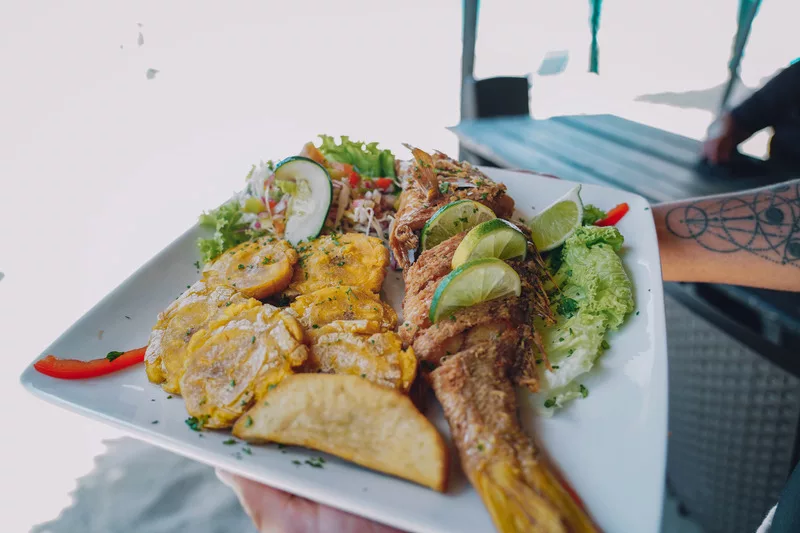
Sleep:
For Beachfront opulence…
In a gated community, luxury villas are dotted around a pastoral terrain spanning 250 acres, where nature meets Caribbean elegance at the Sea Horse Ranch.
The prestigious and tranquil resort has upscale villas with private pools, and some have ocean views. The spacious accommodation resembles a lavish private home with high-quality finishes and attention to detail.
Located in Cabarete, the resort includes a range of amenities and full concierge service. It is also conveniently close to Gregorio Luperón International Airport in Puerto Plata.
Enjoy dining in one of the best sunset settings in the area at The Beach Club, a gourmet oceanfront with panoramic views. Its seasonal menu is influenced by flavours from around the world including the Mediterranean and Caribbean.
There are also opportunities to relax and unwind in one of the secluded private beach coves or refresh yourself with a swim in the pool. If you are feeling more adventurous, Sea Horse Ranch has an equestrian centre that will take you along the pristine beaches and tropical forests, suitable for both advanced riders and novices. Alternatively, why not try the tennis club with five clay courts and private lessons?
Sea Horse Ranch is known for its exclusivity and privacy, making it a sought-after destination for discerning travellers.

LANDMARK ATTRACTIONS
Salto de Jimenoa Uno
This is the most picturesque of the three waterfalls near Jarabacoa. In fact, it is so photogenic that the opening scene of Jurassic Park was filmed here! The 60-metre cascade tumbles into a natural pool below. On a sweltering day, the cool, crystal-clear water invites you to swim with the surrounding rainforest, adding to the ambience. This serene and natural oasis is perfect for connecting with the Dominican Republic’s dramatic landscape, and the scenic views are the perfect opportunity for photographers and nature enthusiasts.
Colonial Zone
The UNESCO World Heritage Site is the historic heart of Santo Domingo. It is renowned for its well-preserved colonial architecture and impressive landmarks such as Catedral Primada de America – the first cathedral in the Americas. The European settlement hosts cultural events and festivals throughout the year and has a beautiful square lined with restaurants and cafés overlooking the Ozama River. It is advisable to book a guided tour, which can provide stories to appreciate the country’s heritage fully.
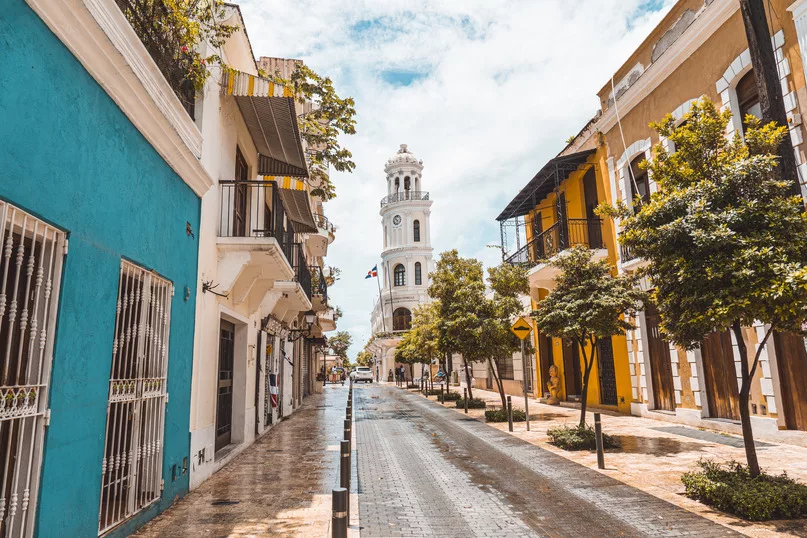
Parque Nacional del Este (Eastern National Park)
This national park is home to diverse ecosystems, including 500 flower species and 300 birds. Beaches, tropical forests, and marine life all comprise this varied landscape. It’s an excellent place for hiking, bird watching, and snorkelling. During the walk, you will be privileged to see protected species, such as the sea grape, the autograph tree, and the kiawe tree, and endangered species, such as the Hispaniola solenodon.
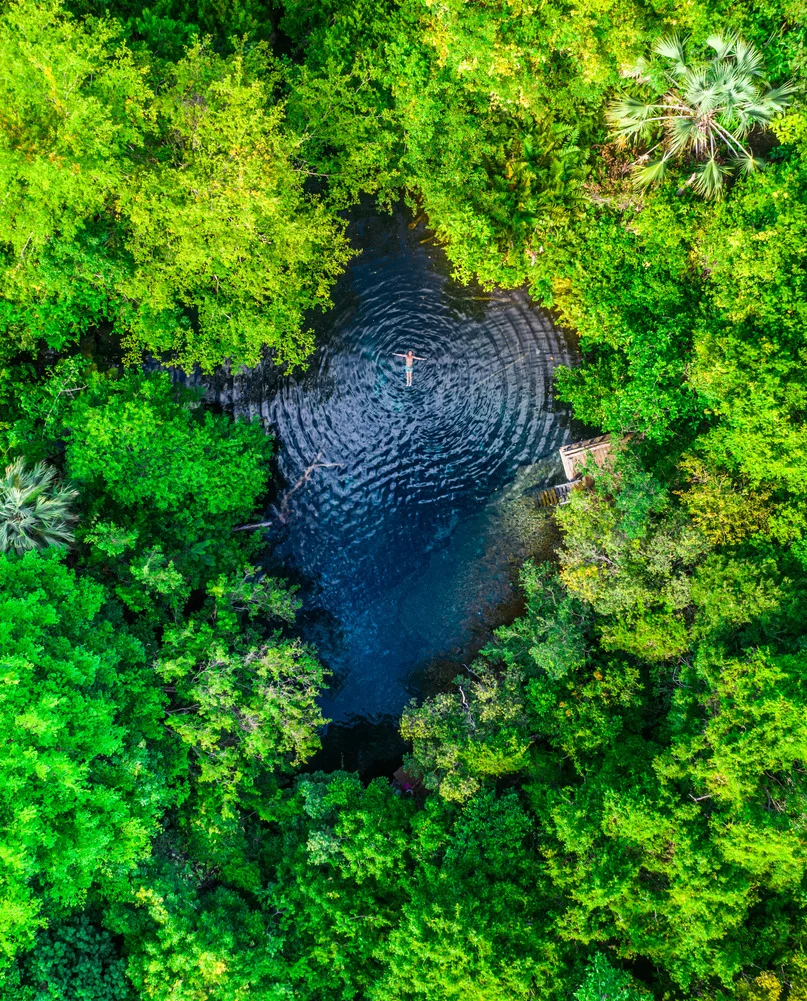
GETTING THERE AND AROUND
The Dominican Republic has several international airports, with Punta Cana International Airport (PUJ) being one of the busiest. Domestic flights connect major cities and tourist destinations.
Public buses and guaguas (shared vans) are the primary modes of public transportation, with guaguas more suitable for smaller jaunts. Taxis and rideshare services are also available but are easier to find in urban and tourist zones.
Renting a car is convenient for exploring the country and ideal for comfort. Still, driving conditions can be challenging, so be cautious, and a robust network of roads links towns and cities to villages and beaches. The island supports all of the commuting done by the locals with an efficient highway system that keeps the population moving.
In Santo Domingo, you will find the Metro, rail-based transport, which stops at popular tourist sites within the city. You can buy a day pass for USD$1.45.
Dominicans are naturally helpful and likely to assist visitors, but accessible transportation in the Dominican Republic can be tough to find in more rural areas. Curb ramps are standard in major downtown hubs like Santo Domingo, Punta Cana and Puerto Plata, and it is easy to find wheelchair-accessible shuttles to hotels. Parking areas rarely have spaces for drivers with disabilities, and most buses and taxis are not wheelchair accessible.
